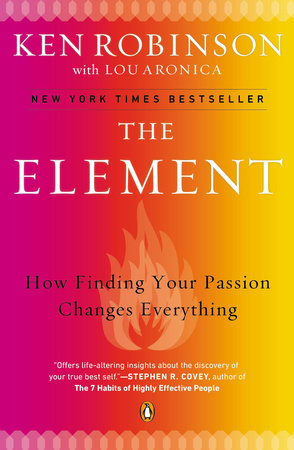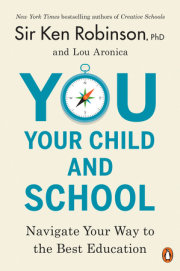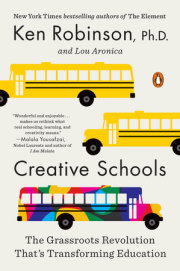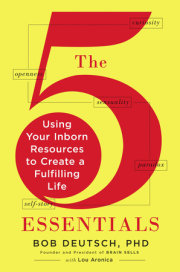CHAPTER ONE
The Element
GILLIAN WAS ONLY eight years old, but her future was already at risk. Her schoolwork was a disaster, at least as far as her teachers were concerned. She turned in assignments late, her handwriting was terrible, and she tested poorly. Not only that, she was a disruption to the entire class, one minute fidgeting noisily, the next staring out the window, forcing the teacher to stop the class to pull Gillian’s attention back, and the next doing something to disturb the other children around her. Gillian wasn’t particularly concerned about any of this—she was used to being corrected by authority figures and really didn’t see herself as a difficult child—but the school was very concerned. This came to a head when the school wrote to her parents.
The school thought that Gillian had a learning disorder of some sort and that it might be more appropriate for her to be in a school for children with special needs. All of this took place in the 1930s. I think now they’d say she had attention deficit hyperactivity disorder, and they’d put her on Ritalin or something similar. But the ADHD epidemic hadn’t been invented at the time. It wasn’t an available condition. People didn’t know they could have that and had to get by without it.
Gillian’s parents received the letter from the school with great concern and sprang to action. Gillian’s mother put her daughter in her best dress and shoes, tied her hair in ponytails, and took her to a psychologist for assessment, fearing the worst.
Gillian told me that she remembers being invited into a large oak-paneled room with leather-bound books on the shelves. Standing in the room next to a large desk was an imposing man in a tweed jacket. He took Gillian to the far end of the room and sat her down on a huge leather sofa. Gillian’s feet didn’t quite touch the floor, and the setting made her wary. Nervous about the impression she would make, she sat on her hands so that she wouldn’t fidget.
The psychologist went back to his desk, and for the next twenty minutes, he asked Gillian’s mother about the difficulties Gillian was having at school and the problems the school said she was causing. While he didn’t direct any of his questions at Gillian, he watched her carefully the entire time. This made Gillian extremely uneasy and confused. Even at this tender age, she knew that this man would have a significant role in her life. She knew what it meant to attend a “special school,” and she didn’t want anything to do with that. She genuinely didn’t feel that she had any real problems, but everyone else seemed to believe she did. Given the way her mother answered the questions, it was possible that even she felt this way.
Maybe, Gillian thought, they were right.
Eventually, Gillian’s mother and the psychologist stopped talking. The man rose from his desk, walked to the sofa, and sat next to the little girl.
“Gillian, you’ve been very patient, and I thank you for that,” he said. “But I’m afraid you’ll have to be patient for a little longer. I need to speak to your mother privately now. We’re going to go out of the room for a few minutes. Don’t worry; we won’t be very long.”
Gillian nodded apprehensively, and the two adults left her sitting there on her own. But as he was leaving the room, the psychologist leaned across his desk and turned on the radio.
As soon as they were in the corridor outside the room, the doctor said to Gillian’s mother, “Just stand here for a moment, and watch what she does.” There was a window into the room, and they stood to one side of it, where Gillian couldn’t see them. Nearly immediately, Gillian was on her feet, moving around the room to the music. The two adults stood watching quietly for a few minutes, transfixed by the girl’s grace. Anyone would have noticed there was something natural—even primal—about Gillian’s movements. Just as they would have surely caught the expression of utter pleasure on her face.
At last, the psychologist turned to Gillian’s mother and said, “You know, Mrs. Lynne, Gillian isn’t sick. She’s a dancer. Take her to a dance school.”
I asked Gillian what happened then. She said her mother did exactly what the psychiatrist suggested. “I can’t tell you how wonderful it was,” she told me. “I walked into this room, and it was full of people like me. People who couldn’t sit still. People who had to move to think.”
She started going to the dance school every week, and she practiced at home every day. Eventually, she auditioned for the Royal Ballet School in London, and they accepted her. She went on to join the Royal Ballet Company itself, becoming a soloist and performing all over the world. When that part of her career ended, she formed her own musical theater company and produced a series of highly successful shows in London and New York. Eventually, she met Andrew Lloyd Webber and created with him some of the most successful musical theater productions in history, including Cats and The Phantom of the Opera.
Little Gillian, the girl with the high-risk future, became known to the world as Gillian Lynne, one of the most accomplished choreographers of our time, someone who has brought pleasure to millions and earned millions of dollars. This happened because someone looked deep into her eyes—someone who had seen children like her before and knew how to read the signs. Someone else might have put her on medication and told her to calm down. But Gillian wasn’t a problem child. She didn’t need to go away to a special school.
She just needed to be who she really was.
Unlike Gillian, Matt always did fine in school, getting decent grades and passing all of the important tests. However, he found himself tremendously bored. In order to keep himself amused, he started drawing during classes. “I would draw constantly,” he told me. “And I got so good at drawing that I was able to draw without looking, so that the teacher would think that I was paying attention.” For him, art class was an opportunity to pursue his passion with abandon. “We were coloring in coloring books, and I thought, I can never color within the lines. Oh, no, I can’t be bothered!” This kicked up to another level entirely when he got to high school. “There was an art class and the other kids would just sit there, the art teacher was bored, and the art supplies were just sitting there; nobody was using them. So I did as many paintings as I could—thirty paintings in a single class. I’d look at each painting, what it looked like, and then I’d title it. ‘Dolphin in the Seaweed,’ okay! Next! I remember doing tons of painting until they finally realized I was using up so much paper that they stopped me.
“There was the thrill of making something that did not exist before. As my technical prowess increased, it was fun to be able to go, ‘Oh, that actually looks, vaguely, like what it’s supposed to look like.’ But then I realized that my drawing was not getting much better so I started concentrating on stories and jokes. I thought that was more entertaining.”
Matt Groening, known around the world as the creator of The Simpsons, found his true inspiration in the work of other artists whose drawings lacked technical mastery but who combined their distinctive art styles with inventive storytelling. “What I found encouraging was looking at people who couldn’t draw who were making their living, like James Thurber. John Lennon was also very important to me. His books, In His Own Write and A Spaniard in the Works, are full of his own really crummy drawings but funny prose-poems and crazy stories. I went through a stage where I tried to imitate John Lennon. Robert Crumb was also a huge influence.”
His teachers and his parents—even his father, who was a cartoonist and filmmaker—tried to encourage him to do something else with his life. They suggested that he go to college and find a more solid profession. In fact, until he got to college (a nontraditional school without grades or required classes), he’d found only one teacher who truly inspired him. “My first-grade teacher saved paintings I did in class. She actually saved them, I mean, for years. I was touched because there’s like, you know, hundreds of kids going through here. Her name is Elizabeth Hoover. I named a character on The Simpsons after her.”
The disapproval of authority figures left him undeterred because, in his heart, Matt knew what truly inspired him.
“I knew as a kid when we were playing and making up stories and using little figurines—dinosaurs and stuff like that—I was going to be doing this for the rest of my life. I saw grown-ups with briefcases going into office buildings and I thought, ‘I can’t do that. This is all I really wanna do.’ I was surrounded by other kids who felt the same way, but gradually they peeled off and they got more serious. For me it was always about playing and storytelling.
“I understood the series of stages I was supposed to go through—you go to high school, you go to college, you get a credential, and then you go out and get a good job. I knew it wasn’t gonna work for me. I knew I was gonna be drawing cartoons forever.
“I found friends who had the same interests at school. We hung out together and we’d draw comics and then bring them to school and show them to each other. As we got older and more ambitious, we started making movies. It was great. It partly compensated for the fact that we felt very self-conscious socially. Instead of staying home on the weekend, we went out and made movies. Instead of going to the football games on Friday night, we would go to the local university and watch underground films.
Copyright © 2009 by Ken Robinson. All rights reserved. No part of this excerpt may be reproduced or reprinted without permission in writing from the publisher.










